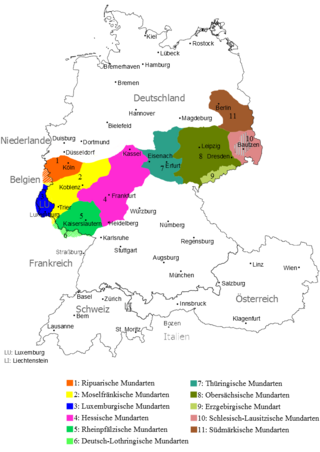

| Thuringian | |
|---|---|
| Thüringisch | |
| Native to | Germany |
| Region | Thuringia |
Early forms | |
| Language codes | |
| ISO 639-3 | – |
| Glottolog | thur1252 |
| Glottopedia | Thüringisch[1] |

Central German dialects after 1945 and the expulsions of the Germans
Thuringian (7) | |
Thuringian is an East Central German dialect group spoken in much of the modern German Free State of Thuringia north of the Rennsteig ridge, southwestern Saxony-Anhalt and adjacent territories of Hesse and Bavaria. It is close to Upper Saxon spoken mainly in the state of Saxony, therefore both are also regarded as one Thuringian-Upper Saxon dialect group. Thuringian dialects are among the Central German dialects with the highest number of speakers.
Thuringian emerged during the medieval German Ostsiedlung migration from about 1100, when settlers from Franconia (Main Franconia), Bavaria, Saxony, and Flanders settled in the areas east of the Saale River previously inhabited by Polabian Slavs.
The Thuringian dialect is characterized by a rounding of the vowels, the weakening of consonants of Standard German (the lenition of the consonants "p," "t," and "k"), a marked difference in the pronunciation of the "g" sound (which is most common in the areas of North Thuringia and Saxony-Anhalt areas), and a highly-idiosyncratic, melodic intonation of sentences. The second German consonant shift manifested itself in a manner different from that elsewhere in the areas that spoke High German. In many words, "b" is pronounced as "w" or "f" would be in Standard German. For example, the word "aber" (but) is pronounced as "awer". The Thuringian dialect has advanced beyond the stage of basilect.

Grouping according to German dialectology:[2][3]
Another way to subdivide it is:[4]
| Authority control databases: National |
|
|---|